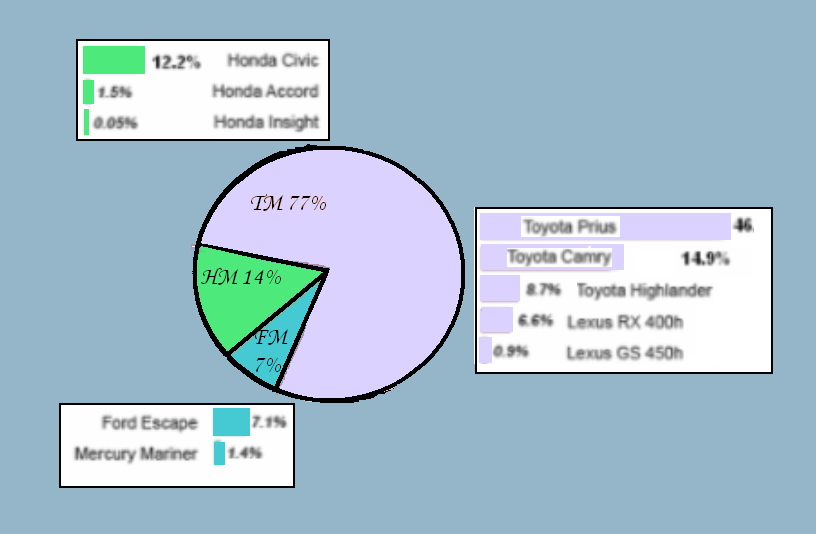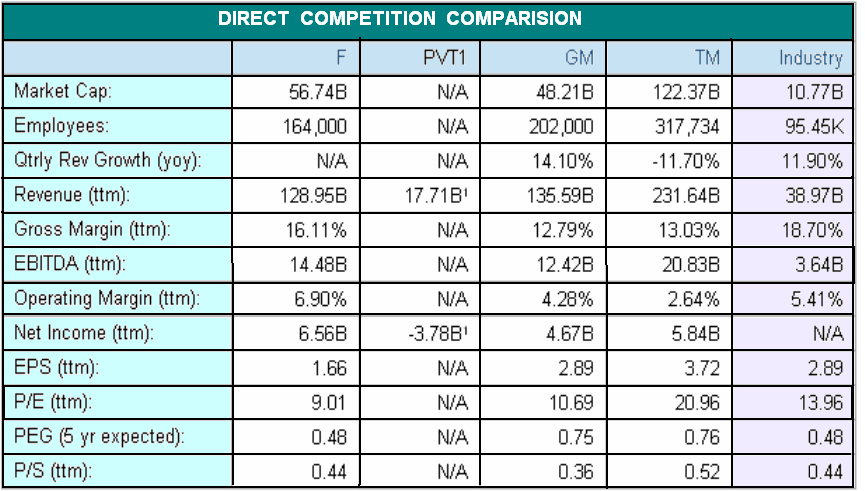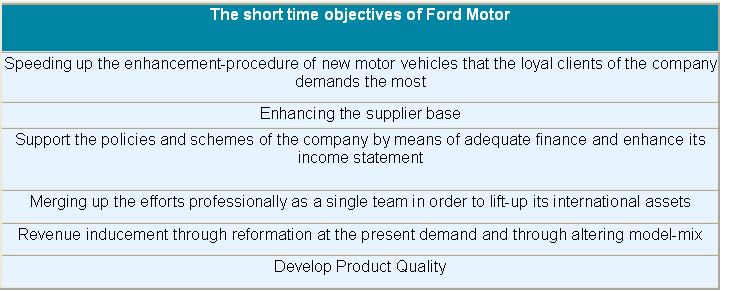- Business-level Strategy of Ford Motor Company
- Porter’s Five Forces Model and Position of the Ford Motor Company
- Managing Customer Relationships to Increase Strategic Competitiveness
- Effective Way to Differentiate Products at Low Costs
- Role of Strategic Leadership to Meet Strategic Objectives
- Bibliography
Business-level Strategy of Ford Motor Company
Sameer Kirtane et al argued that market share of Ford Motor decreased dramatically in the US market and its sales profit dropped more than $1 billion in 2006 due to lack of implementation of effective strategies though it changed leadership approach in 2005. As a result, Ford followed a real business-level strategy to be more cost effective company, for instance, it reduced operating costs, and offered generous buyout packages.
According to the annual report -2010 of Ford, the management team of this company decided to increase investment on the potential new models, suggests the employees to work as a team with shift model mix and adopting functional strategies, for instance, it would close three Ford-plants including one ACH-plant by 2011 that would result decreasing automobile debt by $10.1 billion.
Enhancing Ford Motor’s Value-Chain Links To Create Value for the Firm
Value chain structure works as a determinant for potential profit of the major players in a particular industry paying attention on industry’s present appearance.
However, in order to compete better in this era of globalisation, it is essential for the Ford Motor Company to focus on developing its value chain links. The value chain links could be enhanced by improving its infrastructure, human resources management, procurement, and technology in the way suggested below: –
- Infrastructure: – The management team should review the changing strategic decisions with IT infrastructural strategy, and acquire or joint venture with other competitors and it would be greatly benefit its value chain links;
- Human resources management: – Ford should also arrange numerous training program for the pilot, crew, and other employees in order to minimize risks, increase efficiency, and satisfy the customer;
- Procurement: – These activities should be coupled with the concerns on supply chain management by ensuring more efficiency on supply chain with IT enabled customer services of online services can reconcile any gap in the value chain links;
- Technology: – It is one of the most important factors for Ford, as use of cloud computing in internal organisation can create better communications system.
On the other hand, concentrating on primary functions, pricing strategies, production management systems, customer relationship management, assessment of market situation, route planning, and analysis of the position of major competitors can enhance the value chain of Ford.
Porter’s Five Forces Model and Position of the Ford Motor Company
Rivalry among existing firms
The international motor vehicle industry is exceedingly competitive owing to the existence of a large a number of car producers along with their exceptional offerings. As a result, Ford has to confront numerous smaller and larger rivals at both national and international levels; nonetheless, potential competitors of the company are General Motors, Honda, Mitsubishi, Nissan, BMW, Volkswagen, Toyota, Skoda, Fiat, etc.
Threats from new entrants
Threats from new entrants are comparatively low in the industry because of various barriers to enter the market. New entrants more often lack adequate finances, proficiency, satisfactory knowledge about specialized car manufacturing methods, and skilled personnel. Furthermore, it gets hard for the new players to sustain in the highly competitive business environment after establishment and to join in price competitions with the industry giants.
Bargaining power of buyers
Due to the presence of many automobile producers, the switching off costs of the buyers are relatively high than any other industry sectors; moreover, the customer loyalty is also not significantly noticeable.
Companies like Ford, Toyota, Nissan, Honda, Fiat, etc. offers cars comparatively at the same prices for which it gets easier for the customers to select their desired piece of product from any one of them. However, the bargaining power of the customers seem to diminish when it comes to price considerations of cars companies like BMW or Mercedes as their prices are quite higher than others.
Threats of substitute products
The vehicles of Ford need to contending with several similar product lines of the rival firms; for instance, the substitutes of Ford Taurus and Volvo are Toyota Avalon, Acura RL, Lincoln MKS, etc; Ford Fusion faces competition from Honda Accord, Mercedes C Class, and BMW 3-Series (4-door).
On the other hand, the substitutes of the midsize convertibles of Ford like Volvo C70 are Saab 9-3 and Volkswagen Eos; the substitutes of midsize SUVs like Ford Edge, Ford Flex, Ford Taurus X, and Volvo XC90 are Acura RDX, BMW X3, BMW X5, Honda Pilot, Hyundai Santa Fe, Hyundai Veracruz, Mercedes M Class, Nissan Murano, and Toyota FJ Cruiser.
According to the evaluation of sales in 2006, the existence of so many substitutes create practical difficulties for Ford; in comparison between the sale of Ford’s hybrid-cars, the hybrid-cars of other companies like Toyota-Prius, Toyota-Camry, Lexus RX-400h, Honda-Civic, and Honda-Accord seemed to be selling more than Ford Escape or Mercury-mariner. However, Ford occupied merely 9% share in the US market whereas Honda occupied about 14% share; however, the following figure shows more details –

Bargaining power of suppliers
Annual report of Ford Motor (2010) suggested that the suppliers of the company are generally raw materials suppliers those responsible to deliver steel, aluminium, fuel, copper, lead, rubber, etc. therefore, the bargaining power of these suppliers varies as it has to collect product from different countries, for instance, bargaining power of Mexican suppliers differ in accordance with quality and price.
In context, the global automobile industry possesses numerous raw material providers for which their bargaining powers are not too high. The lithium ion battery producing companies are the key supplier group of Ford Motor Company to delivering technical components to producing hybrid cars; as a result, these manufacturers’ bargaining power are a little more than the suppliers of raw materials’ (steel, aluminium, fuel, resins, copper, lead, rubber).
Managing Customer Relationships to Increase Strategic Competitiveness
Second largest car manufacture Ford Motor manufactured more than 7.20 million vehicles worldwide with lots of successful brands and it earned highest revenue through selling the maximum number of car in UK market. However, Toyota Corporation was able to earn highest revenue in 2010 by selling the maximum number of car in global market while Ford was in third position and BMW was not in top ten automobiles; however, numbers of car sales depend on many factors including customer relationship management, price, quality and services.
The customer relationship management of Volkswagen and Toyota is stronger than Ford; therefore, it should need to meet up this gap immediately by introducing effective CRM tools in order to become global market leader in automobiles industry.
According to the view of Stoner et al, there are mainly four obligatory elements, which are vital for successful implementation of CRM and these features have driven from the theoretical framework of CRM implementation and these tools have showed in the following figure –

Robert Grant notes, ‘four crucial elements help practice of CRM at any organisation’ and these are relationship marketing, appropriate organisational structure, manage of data warehouse and data consumption for effective customer management, and the four elements generate the framework of CRM necessary for any organisation that intend to develop their CRM strategies. As a result, the CEO of Ford would suggest the board of the company to follow the above model along with other business strategies in order to get better outcomes.
The marketers of Ford identified that CRM system of automobile industry has turned just into a slogan rather than appropriate integration due to lack of knowledge about core values of CRM; therefore, the CEO of Ford reported that the company should more concentrate on this issue though it has already integrated SAP to know the comprehensive view of the customers. However, Ford should develop successful CRM program to influence customers regarding its new products and it should use multimedia marketing strategies to increase sales revenue and decrease its investment risks.
In order to avoid late response from the company side, the marketers need to take prompt initiatives to upgrade data base system to collect and retrieve data about the customers and need to increase number of call centre to provide reply on time. In addition, development of communication skills is one of the most important factors for Ford to expand its operation all over the world and to give right message to the customers regarding new products, after sales service, new offers and so on.
Moreover, Ford needs to take technological advantages and integrates Microsoft Dynamics of CRM in order to solve the problem of the customers; consequently, it should increase budget to arrange regular training program and integrate other relevant software.
Effective Way to Differentiate Products at Low Costs
To differentiate its products efficiently at low costs, the business should focus on its manufacturing progressions – costs can be reduced by adopting Japanese manufacturing process, just in time management, specialisation approach, and entire superiority management or QC techniques. Conversely, introduction of innovative technologies and focus on advertisement through celebrity endorsements together with total quality management will be able to create adequate differentiations
Competitor Analysis
Reuters notes that the main competitors of Ford are Toyota Motor Corporation from Japan, General Motors Corporation from United States, Honda Motor from Japan, Chrysler Group LLC from United States, Hyundai Motor from South Korea, Volkswagen from Germany, BMW from Germany, Nissan from Japan, Mazda from Japan, Mitsubishi from Japan, Fiat from Italy, Mercedes from Germany, and Skoda etc. However, the following table shows the direct comparison among major rivals of automobile industry –

Learning Outcomes from Competitive Situation
From the competitive position of the company analysed in the paper before, it can be concluded that Ford is in a comparatively superior position than major competitors. However, to survive in this tough competition in long-term, it is important for the business to offer vehicles at lower prices like Toyota, to emphasize more on eco-friendly and hybrid cars, and to follow the strategic leadership approach and to introduce effective corporate governance system.
Role of Strategic Leadership to Meet Strategic Objectives
Ford was the first company of the world, which adopted the dictatorial approach of Taylor in its business; later on, the company has adopted autonomous approaches to some extent with time, but it is important to argue that a single form of leadership style may not be sufficient to manage the business effectively. This is because firms may need to uphold different leadership styles in different times, for instance, during tough times, paternalistic form of leadership will play important role, whilst autonomous management will work best if the employees in a particular sector are highly efficient.
Therefore, it is significant to the business to adopt a situational approach of leadership, which would help Ford to take the right decisions at right time to meet the strategic objectives. However, the short time objectives of the firms include in the following figure –

Currently, the market situation of the company is not in very good position as Ford suffered significantly from the recession throughout the FY 2010; therefore, it should need effective plan to attain its ultimate objective to be market leader and to recover quickly from this situation by introducing strong leadership style instead of flexible approach.
In fact, paternalistic approach may not suffice to face global financial crisis. In this context, the CEO of Ford Motor should adopt a situational approach of leadership to be market leader in the UK market and to achieve the short time objectives.
Bibliography
Ford Motor. One Ford Annual Report 2010: Ford Motor Company. Web.
Grant, R, Contemporary Strategy Analysis and Cases: Text and Cases, 7th edn, Blackwell Publishing, London, 2010.
Kirtane, S, R Shukla, & L Wang. Is The Way Forward Really Ford’s Way Forward? 2006. Web.
Reuters. Ford Motor Company (F.N). 2011. Web.
Stoner, F, F Edward & G Daniel. Management, 3rd edn, Prentice-Hall, Delhi, 2003.
Yahoo Finance. Direct Competitor Comparison Ford Motors. 2011. Web.